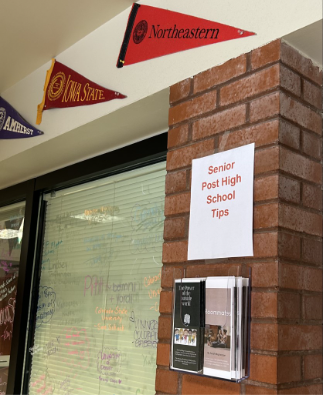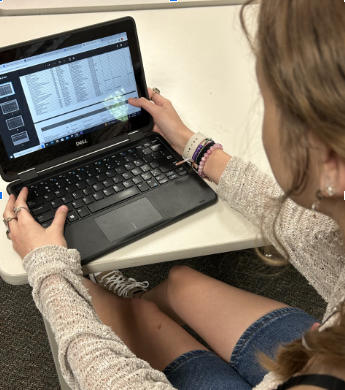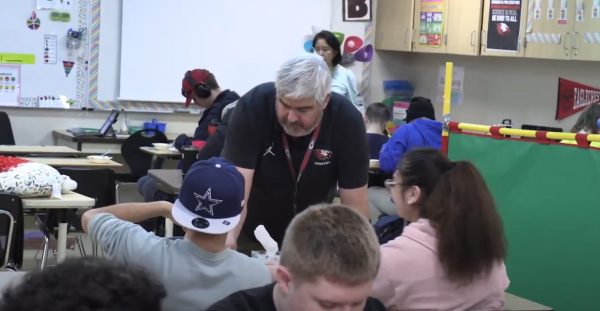How to Navigate the College Process as a Low-Resource Student
Experts in the field of higher education offer information for low-resource students to use when finding and applying to colleges.
As Eaglecrest juniors head into the summer thinking about college, it can be an exciting time for those who are financially stable. For students who are questioning if they should attend college because of financial issues, the idea of higher education is nothing but stressful. In order for a student to make the right decision for themselves in regards to higher education, it is important that low-resource students clear up all misconceptions they may have about college, understand what higher education means for their future, and know what resources are available to them.
Spencer Fox, a former Raptor and current Campus Visit Coordinator for The University of Texas at Austin, was a first-generation college student himself and recalls feeling like loans were his only option.
“We sort of started with the experience not knowing anything about it because our parents did not go,” said Fox. “We just [said], ‘I guess it cost this much. I guess we will take out the loans.’”
Marine Khalighi, the founder of the nonprofit EEqual, has also seen a lack of awareness of financial resources when working with homeless and first-generation teens.
“Many of our students who apply for our scholarship program, their parents did not go to college. They do not know what the ropes are, they do not know how to apply for things, they do not know what resources are available to them,” Khalighi said. “It is just really a lack of knowledge of how the system works that keeps a lot of people out of higher education.”
Because there is a lack of knowledge of what resources are available, many low-resource teens have the idea that they cannot attend college because of their financial situation. Eaglecrest Post Graduate Counselor Sean Hiland believes that could not be farther from the truth.
“If you are a top-level student and finances are the only issue, oh my gosh, we can deal with that all day,” said Hiland. “We have had students from Eaglecrest that go to a school that is $70,000 and they end up paying five to seven [thousand] per year, which is only paying a little bit more than going to [Community College of Aurora].”
After clearing up misconceptions that low-resource students have about higher education, it is important that students know what higher education can do for their future. Hiland is not trying to force college on students but believes that for the sake of your future, skill development outside of high school is necessary.
“If you have a job that someone can learn the skills that are necessary for that job in maybe a day or two or even a week, you are never going to be able to probably have a living wage like you should, nor will you have the security that is necessary to kind of feel comfortable in your career,” said Hiland. Hiland believes that college, a technical or trade school, and apprenticeships can all build these skills.
Outside of skill development, Fox found that higher education enabled growth and created new educational experiences for him.
“I left Eaglecrest in 2014 and I went to Louisiana. I was able to get out of my bubble and meet all kinds of different people,” Fox recalled. “I just [had] an educational experience that was way different. When you get to college, it is about teaching you what are different ways to challenge yourself and the world around you and different ways to think about things.”
If after knowing what higher education can do for your future and you decide that college is the right path for you, low-resource students should consider looking at specific characteristics in a school while exploring colleges. Fox believes that the first thing to look for in a school is a program that you are passionate about.
“Go to a place that is going to have something you are going to be passionate about studying for the next four years,” Fox recommends.
Hiland recommends that students deeply consider the amount of specific support they will receive at colleges they are interested in.
“I want to find out the graduation rates and where are the supports for what type of student I am,” Hiland said. “Am I first-gen? Are there first-gen supports? Am I a student that is having a difficult time paying for school? What kind of supports are there?”
To research these support systems, Hiland recommends that students utilize the National Center for Educational Statistics website.
“On National Center for Educational Statistics, you can actually go in and sort it by first-gen students, you can sort it by race and ethnicity, and what the four-year graduation rate is, not just overall, but for a person that looks like you,” said Hiland.
After students understand what they should be looking for in a college is when the comparison of out-of-state vs. in-state colleges comes into play. Using the University of Colorado Boulder as an example, Hiland illustrates how poorly Colorado funds its public institutions.
“We are in the bottom 10 of the country for how we fund. CU Boulder is $30,000 a year. However, if you were to come from out of state, it’s $52,000,” said Hiland. “But the equivalent flagship public school in other states is usually 23, 24, 25 at best. And ours is 30.”
Because of this lack of funding, Hiland usually directs low-resource students out-of-state.
“If a student is having financial issues, I am going to point them in the direction going out of state but not to another state school,” Hiland said. “If you go out of state, you are going to pay out-of-state fees because you did not pay into their property tax system.”
If the price is right and students find an out-of-state school that they want to attend, it is hard to whole-heartedly decide if that is the school for them until after a visit. Fox has a few recommendations for students who cannot afford to travel and visit these schools, starting with one of the few benefits of the pandemic–virtual tours.

“My advice to students who cannot visit out-of-state colleges is to get as involved in other ways of learning about those programs as possible,” said Fox. “Do any kind of virtual information sessions. You can call those departments if you have questions about specific programs to get as much in-depth information as possible.”
For EHS students, the College and Career Center is a great place for low-resource students to get exposure to out-of-state schools.
“We have a number of schools that visit the College and Career Center every year, usually over 100,” said Hiland. “The last week of September and the first week of October are our busiest.”
Meeting with representatives from these schools is so impactful because of how it affects your application status.
“The person that comes here is not here to advertise a school, it is actually our regional rep. They will be the first read of your application,” said Hiland. “Let us say that we have Wellesley College from Massachusetts comes out, they are the Rocky Mountain Regional Rep. Meaning, that if you were to apply, they will read your application and your essays first. You are making a connection, you are now in the database. You are no longer a stealth applicant, you are an applicant of interest.”
When students have finally found colleges that meet their future needs is when scholarships and resources become extremely important for low-resource students. When applying for scholarships, Hiland recommends stacking smaller scholarships instead of only going after large scholarships.
“Everybody wants to go for the home run scholarships. That is great, but you have to understand the numbers. You are going to be going up against 10, 20, 30, 50 thousand students,” Hiland said. “Do not avoid the scholarships that are 3-4 thousand dollars because, many times, you are not going up against that many [students].”
When it comes to more local scholarships, Hiland and Fox both believe that students need to focus more attention on the scholarships within their community. Looking back on his college journey, Fox wishes he had looked for financial assistance locally, as he has seen students who look within their community come out successful.
“Local businesses, places where your parents work, any kind of like religious service or volunteer organization that you might be a part of, look around you. Those folks are going to be so happy to help their neighbor. A lot of the time there is a lot of money out there that people just do not think about,” said Fox.
Within EHS specifically, there are opportunities for financial assistance that are not well known.
“Eaglecrest has many in-house scholarships just for Eaglecrest students,” said Hiland. “We have like 3 or 4. Many times, we only have 2 or 3 dozen students apply for it.”
Outside of scholarships, there are a number of resources available to inform low-resource students about their options and opportunities. Within EHS, the College and Career Center and EHS College Prep Club are the places to be for college assistance.
The College and Career Center is great for specific questions and information pertaining to your own college journey and college application process.
“If the finances are the issue, come in, have a conversation with either me or your counselor, and we can unpack what some of the obstacles are,” said Hiland. “There is over 2000 colleges in the United States, and you are not gonna know all of them; US News and World Report is like the worst place to start your search because those rankings are faulty.”
If you are looking for more general, consistent help and information about college and the application process, EHS College Prep Club could be a big help. The club is open to all juniors and meets Friday after school from 3:30-5:00.
“Half the time we do test prep and the other half of the time I’m presenting on everything from the common app, to scholarships, to topics of like how to choose proper schools that not only fit your academic profile but your family’s financial profile,” said Hiland. “If you want to be a part of a group that’s really driven to succeed at the next level, get your butt in there.”
As Khalighi and EEqual work with primarily homeless high school students, Khalighi’s recommended resources pertain more towards homeless students or students with exceptional financial needs.
“A lot of time with homeless students, they should be eligible for complete financial aid and Pell Grants if they fill out their forms properly,” said Khalighi. “A big part of our advocacy work at EEqual is really focused on making sure that students know how to access the resources that are available to them.”
Khalighi recommends, specifically for homeless students, The SchoolHouse Connection scholarship program and the EEqual scholarship program. EEqual will open up scholarship applications again in November of 2023. Khalighi also recommends that homeless students reach out to their McKinney-Vento liaison, as every district has one that will help homeless students throughout the college application process.

It is extremely important that low-resource students take advantage of these opportunities because of the generational impact higher education has on not just the student, but families as well.
“Follow the money,” Khalighi said. “It is not just one generation of students who, when they are shut out of higher education, are not able to advance further in their lives, but there is a high likelihood that disadvantage will be passed on to their families as well,” said Khalighi.
The resources needed for low-resource students to go to college are out there–it is just a matter of doing the work to find and attain them. Hopefully, after understanding the help that is available, students will know where to look for assistance and no student will feel that college is out of reach.

Georgia Lujan is a Senior and the editor-in-chief in her second year on staff. She enjoys writing feature and entertainment stories, especially when Taylor...










